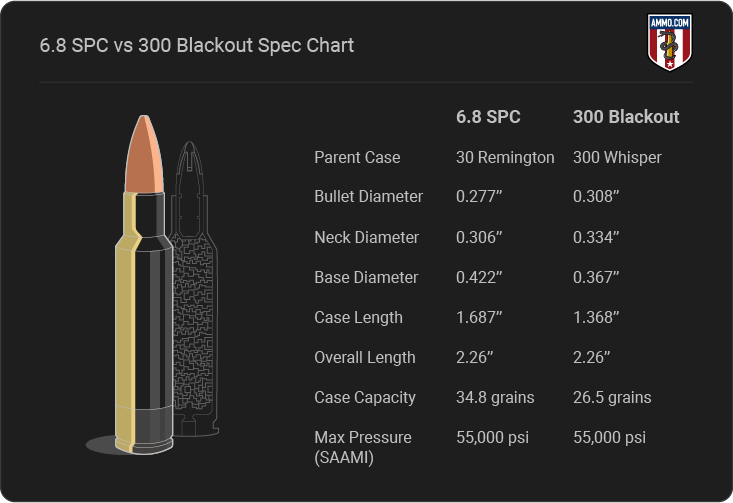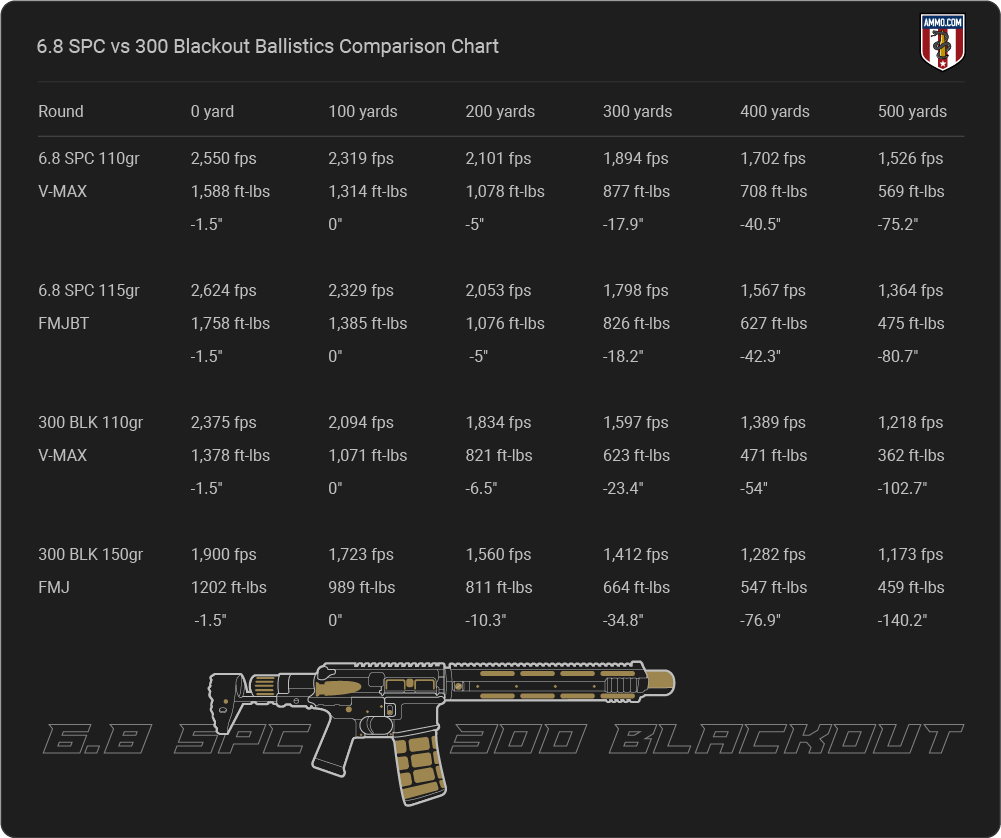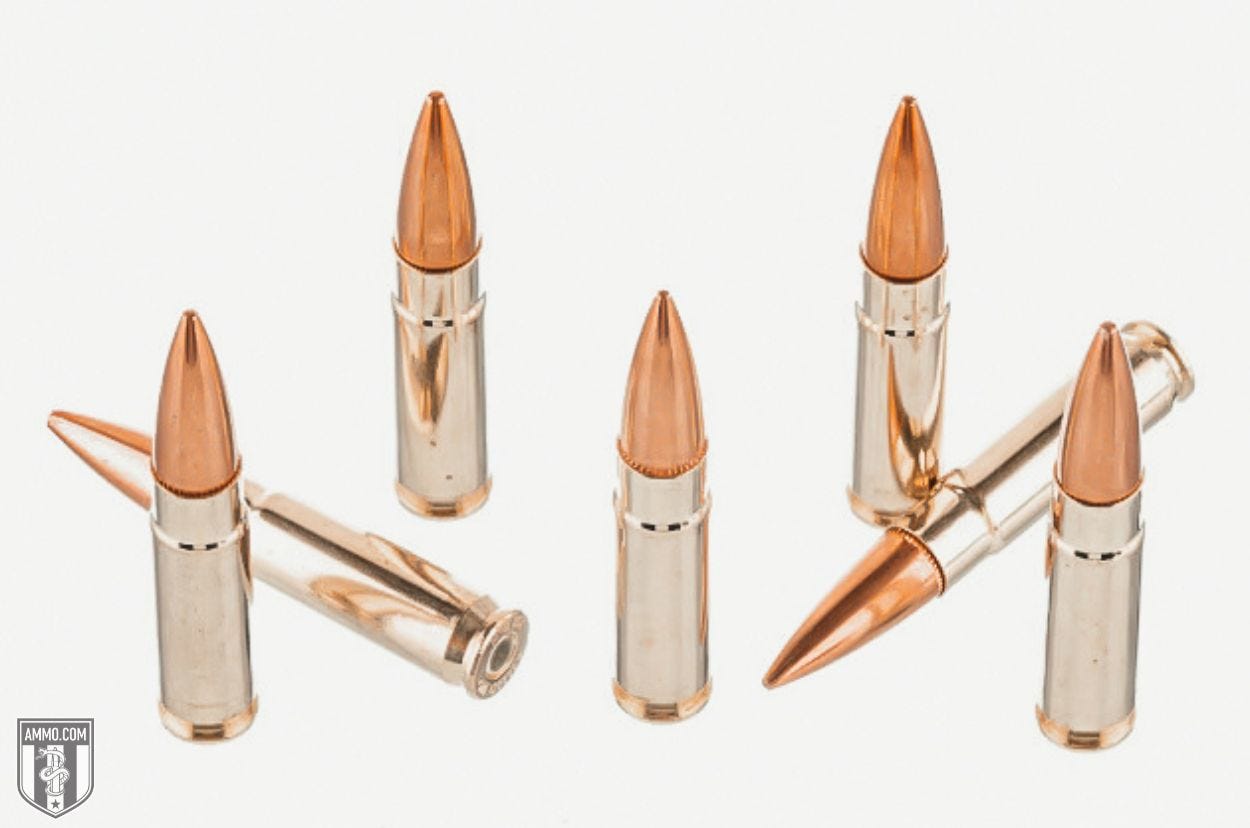 6.8 SPC vs 300 Blackout
6.8 SPC vs 300 Blackout
IPFS
6.8 SPC vs 300 Blackout: Powering Up the AR Platform
Written by Sam Jacobs Subject: Gun RightsIf you want to increase the stopping power of your standard AR-15 chambered in 5.56 NATO, then the 300 Blackout and 6.8 SPC are excellent options.
Both rifle cartridges offer improved terminal ballistics over the 5.56 and function well for home defense, hunting, and general target shooting.
Whether you're looking to invest in a dedicated rifle or simply swap upper receivers, deciding which caliber to choose can be daunting.
In this article, I will give you the straight facts about these two calibers and help you decide which of these two rifle cartridges is the best choice for your next AR-15.
What's the Difference Between 6.8 SPC and 300 Blackout?
The most significant difference between the 6.8 SPC and 300 Blackout is the caliber bullet each round fires. The 300 Blackout is designed to fire the classic 30-caliber 0.308" diameter bullet, while the 6.8 SPC fires a 0.277" diameter bullet. Furthermore, the 300 Blackout will typically fire heavier bullets than the 6.8 SPC.
Cartridge Specs
When evaluating centerfire cartridges, it's a good idea to analyze the cartridge specs to gain more knowledge of each.
Perhaps the most striking difference between these two cartridges is the caliber bullet each fires. The 300 AAC Blackout fires the iconic American 30-caliber bullet, 0.308" diameter like a 308 Win, while the 6.8 SPC fires a 0.277" diameter bullet like a 270 Winchester.
Although both cartridges fire a different diameter bullet, they were both developed using 30-caliber cartridges. The 300 Blackout hails its lineage from the 300 Whisper, while the 6.8 SPC was birthed from the classic 30 Remington case.
Both rounds have the same overall length of 2.26" as they are intermediate cartridges designed to fit into a standard AR-15 action.
However, when you look at these cartridges side-by-side, you can clearly see that the 6.8 SPC is wider with a 0.422" base diameter compared to 0.367" for the 300 Blackout. This striking design difference is one of the major differences between the two cartridges, as 300 Blackout is designed to fit in standard 5.56 mags while the 6.8 SPC requires special magazines for ideal functionality.
One thing to note about the 300 Blackout is that it uses the same bolt as a 5.56 NATO AR-15 carbine, while the 6.8 SPC requires a new bolt for caliber conversion. Both rounds require a barrel change, but in terms of ease of conversion, the 300 Blackout requires less specialized parts.
The drastic difference in case width also translates into the 6.8 SPC having a higher case capacity than the 300 BLK. The 6.8 SPC case can hold 34.8 grains of powder, while the capacity for the 300 Blackout is only 26.5 grains.
Although the 6.8 SPC can pack in a little over 8 grains more propellant, both cartridges have a max chamber pressure of 55,000 psi per SAAMI regulations.
Recoil
If you were thinking the 6.8 SPC has more free recoil due to its higher case capacity, you'd be correct.
Recoil is an important consideration when purchasing a new rifle, as a round with heavy recoil will be more difficult to control and will slow your rate of follow-up shots.
Recoil is affected primarily by muzzle velocity (FPS), powder charge, bullet weight, and rifle weight.
On average, the 6.8 SPC will have around 9 ft-lbs of free recoil compared to about 6 ft-lbs for the 300 Blackout. Although this means the 6.8 SPC has 50% more recoil than the 300 BLK, most shooters would categorize both rounds as being very soft shooting.
For comparison, the 308 Winchester typically has a free recoil of around 20 ft-lbs, so you can see that both the 6.8 and 300 Blackout are very easy on the shoulder.
However, if you're recoil-sensitive or are training a new shooter, the 300 Blackout would be the better choice.
Trajectory, Muzzle Velocity, and Kinetic Energy
Before you make the commitment to a caliber conversion, it's a good idea to compare the ballistics of each rifle cartridge and understand their capabilities.
For this example, we will compare the muzzle velocity (fps), muzzle energy (ft-lbs), and trajectory (bullet drop) for four different factory loads.
For the 300 Blackout, we will examine the Hornady Black 110-grain V-MAX and Federal American Eagle 150-grain FMJ. For the 6.8 SPC, we will consider the Hornady Black 110-grain V-MAX and the Prvi Partizan 115-grain FMJBT. The Hornady loads were selected to offer as close of an "apples to apples" comparison as possible.
The Hornady 110-grain bullets really tell the story here and showcase how the increased case capacity of the 6.8 SPC helps it pull away from the 300 Blackout.
At the muzzle for the Hornady loads, the 6.8 SPC has about 200 fps and 200 ft-lbs edge over the 300 Blackout. As the bullet travels downrange, the 6.8 SPC continues to pull away. At 500 yards, both 300 Blackout loads have gone subsonic (and their trajectory obviously suffers), while the 6.8 SPC is still supersonic at this range.
Overall, if you're looking to shoot longer distances with these two cartridges, the 6.8 SPC is clearly the better choice, as it has a flatter trajectory and can maintain supersonic velocities
longer.
Ballistic Coefficient and Sectional Density
Ballistic coefficient (BC) is a measure of how aerodynamic a bullet is and how well it will resist wind deflection. Sectional density (SD) is a way to evaluate the penetration ability of a bullet based on its external dimensions, design, and weight.
Typically, longer and heavier bullets will have a higher BC as they can resist wind drift more efficiently.
When comparing bullets of similar weight, like our two 110-grain V-MAX loads in the previous section, the 6.8 SPC will have a slight advantage in BC (0.370 vs 0.290) and SD (0.205 vs 0.166) as it fires longer, more slender bullets than the 300 Blackout.
However, the 300 AAC Blackout is also designed to fire heavier subsonic loads that outstrip the 6.8 SPC in both categories. For example, it is not uncommon for 200+ grain weight 30-caliber bullets to have a BC over 0.50 and SD over 0.30.
Therefore, when it comes to ballistic coefficient and sectional density for the 300 Blackout and 6.8 SPC, we have a rather mixed bag of results that are incredibly load and bullet-design dependent.
Accuracy
Accuracy is extremely difficult to quantify when comparing two different rifle cartridges since accuracy is more a byproduct of the firearm being used and the shooter pulling the trigger.
Generally, most shooters prefer a round with lower recoil as the likelihood of developing a trigger flinch is lower. Furthermore, low recoil allows for faster follow-up shots, making it easier to get multiple rounds on target quickly. This would suggest that the 300 Blackout is easier for shooters to be accurate with.
However, the 6.8 SPC has a flatter trajectory, making it a more forgiving cartridge for long-range
shots.
Although both rounds are incredibly accurate, the 300 BLK will likely be easier to be accurate in close-quarters battle (CQB), while the 6.8 SPC will be better for long-range shots.
Hunting
Both the 300 Blackout and 6.8 SPC are exceptional hunting rounds, even if they weren't initially designed for this purpose. However, the 6.8 SPC gives hunters a bit of an edge with a longer effective range and higher muzzle energy for larger game like whitetail or feral hogs.
Although the 6.8 SPC offers several ballistic advantages over the 300 Blackout, the 300 should not be marginalized as a hunting caliber, especially if you hunt in heavily wooded areas. Within 150 yards, the 300 Blackout will have no problem dropping a whitetail deer or a hog where it stands (with proper shot placement, of course).
In this way, the 300 Blackout is similar to the heavier thumper rounds like the 450 Bushmaster, 458 SOCOM, and 50 Beowulf, except the 300 Blackout has considerably less recoil.
But if you plan on taking a longer range shot upwards of 250 to 300 yards, the 6.8 SPC is clearly the better choice as it has the energy to ethically harvest a deer at those ranges.
For varmints, the 300 Blackout offers shooters a low recoil option that works well for groundhogs, raccoons, and coyotes. The 6.8 SPC can also do the job but at the cost of slightly higher recoil.
Which is Better for Deer Hunting?
For deer hunting, both rounds can get the job done with proper bullet selection. Given that the 300 Blackout fires a 30-caliber projectile, there are a lot of options when it comes to hunting bullets, given the success of larger cartridges like the 308 Winchester, 300 Win Mag, and 30-06 Springfield.
The 6.8mm bullet or 0.277" caliber is not new to deer hunting, though, as the 270 Winchester is an extremely popular caliber for whitetail.
Determining which cartridge is best for deer hunting really depends on your local area and the range at which you expect to shoot a deer. If you hunt in a densely forested area like I do in the Midwest, then a 300 BLK is more than sufficient with a 150-yard effective range.
However, if you plan on taking longer shots between 150 and 250 yards, then the 6.8 SPC is the better choice.
Suppressor Integration
Although the 6.8 SPC seems to be running away with this comparison, tap the brakes because the 300 ACC Blackout is perfect for use with a suppressor.
One of the key design features of the 300 BLK is that it experiences a complete powder burn in only 9 inches of barrel length. This means it is a perfect candidate for a short-barrel rifle (SBR).
Furthermore, 300 Blackout ammo comes loaded in either supersonic or subsonic velocities. And the upside to using subsonic ammo is that it's hearing-safe when used with a suppressor.
Although there's no downside to using a suppressor with a 6.8 SPC, there currently are only supersonic ammo offerings for the cartridge.
Self-Defense/Home Defense
Another category where the 300 Blackout really shines is home defense or self-defense scenarios.
One thing that many shooters often forget is how sound bounces off walls, making a rifle report sound even louder indoors. As it plays extremely well with a suppressor, the 300 Blackout makes a great choice for home defense as it has multiple subsonic ammo options.
As these rounds are hearing safe with a suppressor and the heavier bullet weight of these subsonic rounds have impressive terminal ballistics, they offer homeowners an option that has less chance to over-penetrate but can easily stop any home invader.
The lower recoil of the 300 BLK makes it a better choice for close-quarters engagements, as you'll be able to get back on target faster for follow-up shots.
This is not to say that the 6.8 SPC is ineffective at self-defense because it certainly is a potent round. However, given the increased muzzle velocity, there is a higher likelihood for over-penetration, which presents a potentially dangerous scenario where your bullet inadvertently strikes an innocent bystander, neighbor, or family member.
Combined with a shorter barrel and a suppressor, a 300 Blackout AR-15 carbine can make for an extremely lightweight, maneuverable home defense option that has plenty of stopping power to defend your castle.
Ammo and Rifle Cost/Availability
If a 300 Blackout or 6.8 SPC caliber conversion, dedicated upper receiver, or rifle is in your acquisition plan for the near future, it's important to know the availability of parts and ammo.
Considering that any standard AR-15 can easily be converted to shoot either cartridge with a quick upper receiver swap means that you won't run out of host rifles anytime soon. However, if you live in a state or territory that requires hunting with a bolt-action rifle, then the 300 Blackout is your only option at the time of writing.
In terms of parts availability, the 300 Blackout simply has more, as it is the most successful caliber adapted to the AR-15. Numerous companies manufacture barrels or dedicated upper receivers, and since the 300 BLK uses the same bolt as the 5.56 NATO, you have a ton of options.
On the other hand, the Remington SPC is a little more niche, and there are fewer options available for barrels, bolts, and uppers.
The 300 BLK also dominates in terms of ammo availability and price, as cheap plinking ammo can be had for around $0.70/round, while more expensive hunting ammo from companies like Barnes and Nosler can be had for around $2/round at the time of writing.
For those looking to stock up, 300 Blackout bulk ammo options are widely available on our website, offering a cost-effective solution.
On the other hand, the cheapest 6.8 SPC starts around $1.10/round and goes up from there. Also, there are fewer manufacturers who are currently making 6.8 SPC ammo, whereas virtually every ammo manufacturer has at least one offering in 300 BLK, most of which offer both subsonic and supersonic ammo.
Reloading
If you enjoy making your own handloads as I do, then you'll have a good time with either of these cartridges, as there are numerous reloading recipes, powders, and bullets to choose from.
However, the 300 Blackout has a bit of an edge over the 6.8 SPC in terms of brass availability because an experienced handloader can relatively easily convert 223 Remington cases into 300 Blackout cases.
On the other hand, you'll need to either save your once-fired 6.8 SPC cases or buy some from a local range or online, as I'm guessing most handloaders don't have a ton of 30 Remington brass lying around!
As far as bullet availability is concerned, the .308" caliber is about as American as apple pie. We simply love our 30-cals, and there are tons of bullets available in numerous configurations thanks to the success of the 30-06 Springfield, 308 Winchester, and 300 Win Mag.
The 0.277" caliber (6.8mm) is still popular thanks to the 270 Winchester and the new 277 Sig Fury, but bullets will not be as plentiful or inexpensive as 30-caliber bullets.
Continue reading about the differences between the 6.8 SPC vs 300 Blackout ammo here.





















